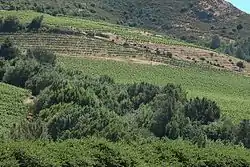| Wine region | |
 Moon Mountain vineyard | |
| Type | American Viticultural Area |
|---|---|
| Year established | 2013[1] |
| Years of wine industry | since 1880[2] |
| Country | United States |
| Part of | California, North Coast AVA, Sonoma County, Sonoma Valley AVA |
| Other regions in California, North Coast AVA, Sonoma County, Sonoma Valley AVA | Bennett Valley AVA, Los Carneros AVA, Sonoma Mountain AVA |
| Soil conditions | Rocky, iron-rich volcanic[3] |
| Total area | 17,633 acres (28 sq mi)[4] |
| Size of planted vineyards | 1,500 acres (607 ha)[4] |
| No. of vineyards | 40[4] |
| Varietals produced | Cabernet Franc, Cabernet Sauvignon, Chardonnay, Malbec, Merlot, Petit Verdot, Pinot Noir, Syrah, Zinfandel[5] |
| No. of wineries | 11[4] |
Moon Mountain District Sonoma County is an American Viticultural Area (AVA) within Sonoma Valley and North Coast viticultural areas, just north of the city of Sonoma. This mountainous region on the very eastern edge of Sonoma County has a historic reputation for producing rich, intensely-flavored wines from Cabernet Sauvignon and Syrah varietals since the 1880s.[2] The District was established on November 1, 2013 by the Alcohol and Tobacco Tax and Trade Bureau (TTB). Its designation covers 17,663 acres (28 sq mi) of land stretching north-south along the western slopes of the Mayacamas mountains between Sugarloaf Ridge State Park and Los Carneros viticultural area with the Napa Valley’s Mount Veeder viticultural area outlining the eastern slopes. Its name is derived from Moon Mountain Road, which traverses through the area and itself a reference to Sonoma, which means 'valley of the moon' in the local Native American dialect.[6] A clear view to San Francisco 50 miles (80 km) south is not uncommon from Moon Mountain District vineyards.[5]
Terroir
The distinguishing features of Moon Mountain District are its topography, geology, climate, and soils. It lies in one of the warmer parts of Sonoma County due to its inland location. At elevations ranging from 400 to 2,200 feet (120 to 670 m) above sea level, vines grow in a variety of soils, mainly rocky and of volcanic origin, on the western slopes and ridge tops of the Mayacamas Mountains. The district's boundaries are outlined by proceeding south along the mountain ridge from the Rutherford locale down the meandering Sonoma-Napa County boundary to the Sonoma-Napa county southeast intersection; then travels southwesterly in a straight line north of Arrowhead Mountain toward the Pueblo lands of Sonoma; the boundary then proceeds northwesterly along the western foothills pass the locales of Eldridge, Glen Ellen, through the Valley of the Moon and settling in the Kenwood vicinity; finally, turning east-northeasterly it proceeds to a marked 1,483-foot peak south of Sugarloaf Ridge and then east-southeasterly in a straight line back to the Sonoma-Napa County boundary.[4]
Climate
Crosswinds from both the Pacific Ocean to the west and San Pablo Bay in the south bring cooling maritime influences to the vineyards, but by the time the winds have travelled across the valley floor they have warmed considerably. Most of the region's vineyards face southwest, subjecting them to stronger afternoon sunlight. The higher elevation vineyards places their varietals above the influence of the famous Sonoma fog. The warmer climate gives Moon Mountain District a longer growing season than other parts of Sonoma Valley, with earlier budburst in the spring and a longer hang time for the grapes in the autumn. Cold air tends to drain off the hillside vineyards into the valley, reducing the risk of damaging frosts and allowing for a long, slow maturation period. As a result, Moon Mountain District grapes have a good balance of sugars and acidity, leading to well-balanced wines.[3]
Soil
Moon Mountain's volcanic origins gave the area's winemakers cause to petition for a separate AVA title, which was approved in 2013. The region's iron-rich volcanic soils are quite distinct from the sedimentary soils of the surrounding area.[4] These red, rocky soils are thin, well-drained and therefore highly suited to viticulture. Louis M. Martini's famed Monte Rosso vineyard, a 120-year-old vineyard within the appellation, is named for these red soils.[2]
Wine Industry
TTB received a petition from Patrick L. Shabram on behalf of Christian Borcher, a representative of the vintners and grape growers in the area, proposed the establishment of the “Moon Mountain District Sonoma County” AVA.[7] Moon Mountain contains 11 wineries and 40 commercially-producing vineyards that cultivate approximately 1,500 acres (607 ha) well-established throughout the mountainous area around the hills and ridges.[4]
References
- ↑ "§9.231 Moon Mountain District Sonoma County" (Title 27: Alcohol, Tobacco and Firearms; Part 9 — American Viticultural Areas; Subpart C — Approved American Viticultural Areas). Code of Federal Regulations. October 2, 2013.
- 1 2 3 Heald, Eleanor & Ray (June 11, 2007). "Sonoma Valley's Legendary Monte Rosso Vineyard: Acclaimed Winemaker Ed Sbragia Explains Its Allure". Appellation America.
- 1 2 "Moon Mountain District Wine". Wine-Searcher.
- 1 2 3 4 5 6 7 "Establishment of the Moon Mountain District Sonoma County Viticultural Area" (78 FR 60690 27 CFR 9 Doc#: 2013-23942). Federal Register. Alcohol and Tobacco Tax and Trade Bureau. October 2, 2013. pp. 60690–60693.
 This article incorporates text from this source, which is in the public domain.
This article incorporates text from this source, which is in the public domain. - 1 2 "Moon Mountain Wine Region and Appellation". Sonoma County Tourism.
- ↑ Bowman, J. N. (July 1, 1946). "The Meaning of the Name "Sonoma"". California Folklore Quarterly. Western States Folklore Society. 5 (3): 300–302. doi:10.2307/1495526. JSTOR 1495526 – via JSTOR.
- ↑ "Moon Mountain District Sonoma County (AVA): Appellation Profile". Appellation America. Archived from the original on March 30, 2016.
External links
- Moon Mountain Wine Region and Appellation Sonoma County Tourism
- Moon Mountain District Sonoma County on Facebook
- TTB AVA Map